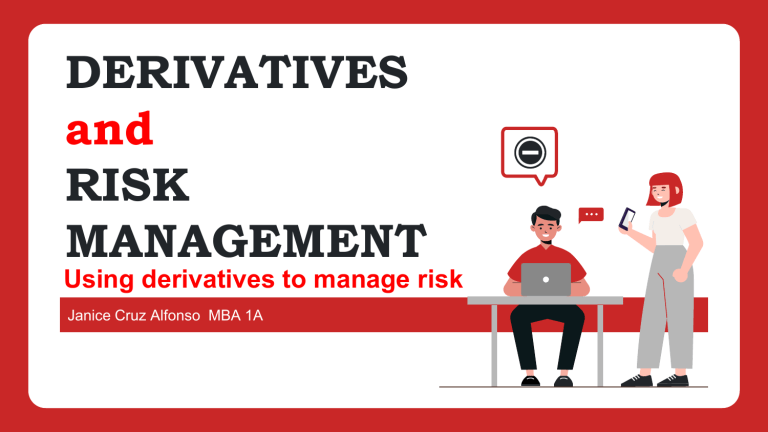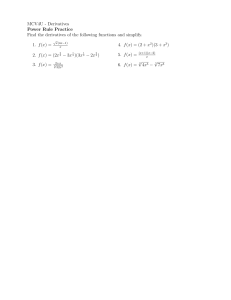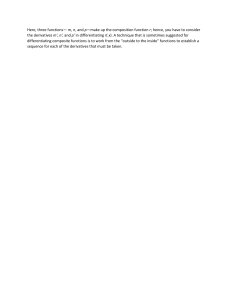
DERIVATIVES and RISK MANAGEMENT Using derivatives to manage risk Janice Cruz Alfonso MBA 1A involves identifying events that could have adverse financial consequences and then taking actions to prevent or minimize the damage caused by these events the continuing process to identify, analyze, evaluate, and treat loss exposures and monitor risk control and financial resources to mitigate the adverse effects of loss helps an organization to identify, evaluate, analyze, monitor, and mitigate the risks that threaten the achievement of the organization's strategic objectives in a disciplined and systematic way 01 02 REASON TO BACKGROUND ON MANAGE RISK DERIVATIVES 04 05 03 OPTIONS 06 FORWARD AND OTHER TYPES OF RISK FUTURE DERIVATIVES MANAGEMENT CONTRACTS 01 Debt capacity Maintaining the optimal capital budget over time Financial distress Comparative advantages in hedging Borrowing costs Tax effects Compensation systems 02 Background on Derivatives financial instrument whose value is derived based on the underlying asset represents a financial contract between two or more parties, and its price is decided based on fluctuations in the underlying asset price a type of financial contract whose value is dependent on an underlying asset, group of assets, or benchmark 02 Background on Derivatives continuation…. One of the first formal markets for derivatives was the futures market for wheat Hedging with futures • • lowered aggregate risk in the economy involves buying one instrument and subsequently selling the other to offset the risk intermediaries came into the picture, and trading in futures was established The Chicago Board of Trade, founded in 1848 and now a member of the CME Group, was an early marketplace where futures dealers helped make a market in futures contracts Speculators, soon enter the scene Natural hedges, situations in which aggregate risk can be reduced by derivatives transactions between two parties (called counterparties), exist for many 03 An option is a kind contract that gives its holder the right to buy (or sell) an asset at some predetermined price within a specified period of time. There are many types of options and option markets Two of them are referred to as in-the-money and out-of-the-money A call option is an out-of-the-money A call option is when the purchaser has a “call”, or the right to decision, on all 100 shares. 03 Call Options give the holder of the contract the right to purchase the underlying security The second form of option gives you the right to sell a stock at a specified price within some future period— this is called a put option. The most important difference between call options and put options is the right they confer to the holder of the contract. Simply put, Call Option is to buy stock/s and Put Option is to sell stocks. 04 Forward and Future Contracts Forward contracts are agreements between two parties wherein the first party agrees to buy the commodity offered at a specific price on a specific future date and the second party agrees to go through with the sale of the commodity. Future contract is similar to a forward contract but with three key differences 04 Forward and Future Contracts continuation… Future Contracts Key Differences (1) Futures contracts are “marked to market” on a daily basis, meaning that gains and losses are noted and money must be put up to cover losses. This greatly reduces the risk of default that exists with forward contracts. (2) With futures, physical delivery of the underlying asset is never taken—the two parties simply settle up with cash for the difference between the contracted price and the actual price on the expiration date. (3) Futures contracts are generally standardized instruments that are traded on exchanges, whereas forward contracts are generally tailor-made, are negotiated between two parties, and are not traded after they have been signed 05 Other Types of Derivatives Options, forwards, and futures are among the most important classes of derivative securities; but there are other types of derivatives, including swaps, structured notes, inverse floaters, and a host of other “exotic” contracts: A swap is just what the name implies—two parties agree to swap something, generally obligations to make specified payment streams. 05 Other Types of Derivatives continuation… Structured notes is a debt obligation that is derived from some other debt obligation. A variety of structured notes can be created, ranging from notes whose cash flows can be predicted with virtual certainty to other notes whose payment streams are highly uncertain. Inverse floater - An inverse floater is a bond or other type of debt whose coupon rate has an inverse relationship to a benchmark rate. With an inverse floater, the rate paid on the note moves counter to market rates. Thus, if interest rates in the economy rose, the interest rate paid on an inverse floater would fall, lowering its cash interest payments. 06 Risk Managements In running a business, it is only natural to run into problems from time to time. Therefore, companies need to always find a way to identify these potential problems to either have precautionary measures to prevent or to solve such risks. Let us begin with some terms to be used Pure risks offer only the prospect of a loss. Speculative risks offer the chance of a gain but might result in a loss. Demand risks are associated with the demand for a firm’s products or services. Input risks are associated with input costs, including labor and materials. 06 Risk Management continuation… Financial risks result from financial transactions. Property risks are associated with destruction of productive assets. Personnel risks result from employees’ actions. Environmental risks include risks associated with polluting the environment. Liability risks are associated with product, service, or employee actions. Insurable risks can be covered by insurance. 06 Risk Management continuation… An Approach To Risk Management: i. ii. iii. Identify the risks that the firm faces. Measure the potential effect of each risk. Decide how each relevant risk should be handled. In most situations, risk exposure can be reduced through one of the following techniques: • Transfer the risk to an insurance company. • Transfer the function that produces the risk to a third party. • Purchase derivative contracts to reduce risk. • Reduce the probability of the occurrence of an adverse event. • Reduce the magnitude of the loss associated with an adverse event. • Totally avoid the activity that gives rise to the risk. Thank you for listening! RESOURCES Derivatives in Finance (https://www.educba.com/derivatives-in-finance/) Financial Management: Theory and Practice. Ehrhardt, Brigham. 13th Edition Fundamentals of Financial Management. Brigham, Houston. 12th Edition Derivatives: Types, Considerations, and Pros and Cons (investopedia.com) Call Options vs. Put Options: The Difference (thebalancemoney.com) Inverse Floater: Definition, How It Works, Calculation, Example (investopedia.com)



